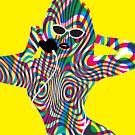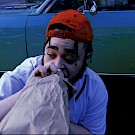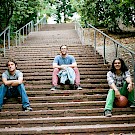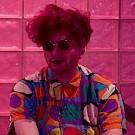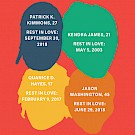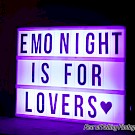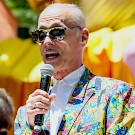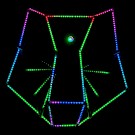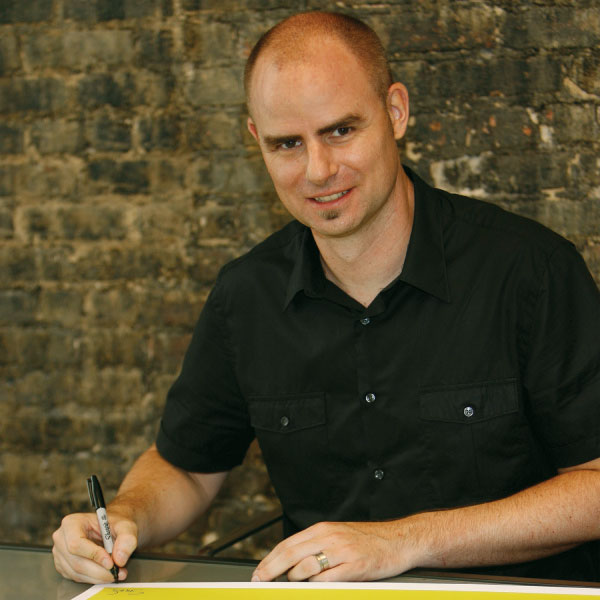 Dan Stiles: The man behind the bright, geometric and sometimes subtly insinuative legal graffiti—aka concert posters
Dan Stiles: The man behind the bright, geometric and sometimes subtly insinuative legal graffiti—aka concert posters
After 20 years of designing iconic concert posters that take advantage of bold geometric shapes and bright color palettes to create striking works of art, Dan Stiles has developed the ability to seamlessly infuse the raw energy of rock music with the simplistic aesthetics of modern design.
Having spent his salad days as a pen-and-ink artist in the DIY punk scene, Stiles ended up creating logos at a major design firm in San Francisco after college. The polarizing experiences birthed a unique style that has become his signature. “I started to make this hybridization of old, lowbrow punk visuals combined with the simplicity of corporate communications, all created using digital tools,” he explains.
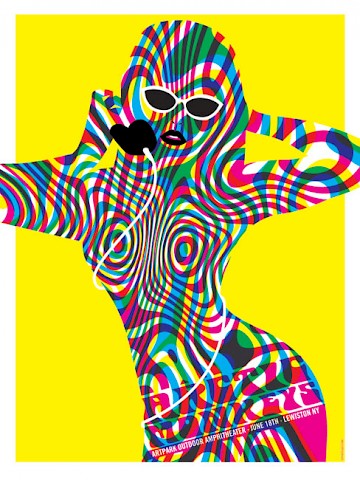 Click to see an entire gallery of work by Dan StilesWhere are you from?
Click to see an entire gallery of work by Dan StilesWhere are you from?
I was born and raised in Ann Arbor, Mich., a college town in the Midwest. It was a cool place to grow up. In the ‘80s, it had this great underground, bohemian, punk, house party scene. All of that is gone now, replaced with condos and coffee shops. But it was fun while it lasted. I moved West for college and never looked back.
Why do you create art in Portland and what keeps you here?
I’ve spent my whole life in cities like this: Ann Arbor, Eugene, San Francisco, Berkeley. With each place, my standards for what I expect from a city rise. I would die in the suburbs or rural America. I need the people, the art, the food, the general weirdness. It’s all become normal to me. Portland has that perfect mix of big-city amenities combined with manageable scale. People come here from all over to make stuff and take part in generating an environment of creativity. This city is the antithesis of driving your Escalade to Olive Garden to watch Monday Night Football after work. I’m not sure where else I could go from here. Austin, Brooklyn, Long Beach? There aren’t many places like this in America.
How did you start making concert posters?
The poster thing happened when I left Ann Arbor and moved to Eugene, Ore., for college, purely because I wanted to snowboard and be close to the Northwest music scene. That was when Mudhoney and all those bands were happening. It was before Nirvana broke—late ‘80s, early ‘90s, pre-‘91 when Nevermind kind of blew the lid off 20 years of hard work that everyone had put into building up the underground. I was living in this huge co-op that used to be a sorority house. I would wander around the house in the middle of the night with a six-pack of beer and a handful of Magic Markers and draw stuff on the walls. There was a guy living there who was involved with a promotion group that would bring bands to play on campus. He saw my stuff on the walls and was like, “Hey, do you want to do posters?” He had to twist my arm at first. Finally he said, “Look, $20 and all the beer you can drink at the show plus free tickets for you and all your friends.” And I said, “Alright, I’ll do it.” And the minute I did my first one, I was sold because it was like graffiti. It’s like legal graffiti because you can do this flyer and someone else would go tack it all over town for you. All of a sudden I went from being a music fan to being part of making the shows happen, all by drawing some skulls on a sheet of paper. It was the first time I realized that my ability to draw was actually a useful skill.
What’s your favorite thing about concert posters as an art medium?
I like the freedom you get to really go there. Most clients try and reel you in because they’re risk-averse. Rock posters can explore the outer limits of whatever weirdness you have rattling around inside your brain. Your job is to take someone who’s already cool and make them look even cooler.
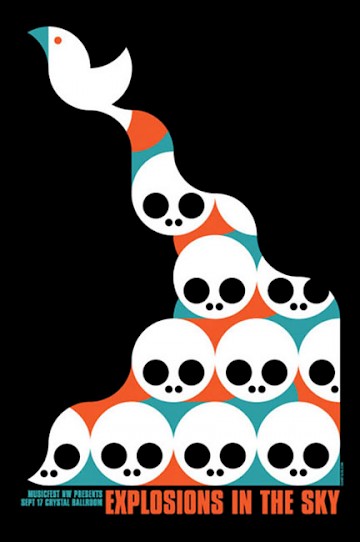 Click to see an entire gallery of work by Dan StilesHow would you describe your aesthetic?
Click to see an entire gallery of work by Dan StilesHow would you describe your aesthetic?
Graphic illustration—a hybrid of graphic design and illustration. Which isn’t a new thing, it’s actually the way most designers worked before the advent of the computer split the job in two. Now you have illustrators who can’t design, and designers who can’t draw. You look at great design from the 1900s through the 1970s and those images were typically created by one person. They came up with the concept, executed the image, developed the type, and laid out the whole page. The whole thing works as a cohesive unit. That’s what I strive for: smart, simple and iconic pieces. I’ve heard my style described as folk-pop and punk rock modern, which I suppose are a bit catchier than graphic illustration and gives more of a nod to my influences.
How did that style develop?
You pick things up and cast things off along the journey of life. You could lay my influences out on a timeline and add them all up into what I do today. The Sunday funnies, comic books, punk rock, lowbrow, art school, logo design, modernism, retro, folk art, abstract expressionism, surface design—it seems like every few years I’m drawn to something new that has a subtle influence on what I make. I never sat down and attempted to create my style; it’s the outgrowth of a lifetime spent in the arts. What I make is a reflection of what I like.
What techniques and materials do you use to create your posters?
A sketchbook, a mechanical pencil, an iMac, a Wacom tablet, Adobe Illustrator and Adobe Photoshop. Those are the core tools. There are other things I use when I need them: markers, an atomizer, sumi ink, technical pens, a camera, a scanner, scissors, Exacto knives, brushes, gouache. Typically I sketch out rough comps to come up with ideas. Once I feel like I have a couple of good leads on ideas, I start to work them out on the computer. Making changes, combining elements, and trying different approaches is so much easier on a computer than doing it by hand. If you don’t like something, you can delete it or change it without having to start over. Once it’s really coming together, I start to play with the color palette and details. Then in the end, I work on finishes like texture, which I typically create by hand and scan in.
What’s your favorite part of the poster creation process?
You can imagine the creative process as a bell curve. There is the uphill battle of coming up with a concept, figuring out how it’s going to look, working it and working it—that part can be really painful. Not always, but sometimes. Then you reach the peak of the curve, the point where it comes together. The idea is good, the imagery is on point. Then comes the downhill ride. That’s where you’re home free and all you’re doing is making the thing look better. Now you would think that the downhill section would be the best, but actually the best part is the moment when you reach the summit. It’s like if Sisyphus finally managed to push that damn boulder up over the edge to the top of the hill. There is a moment of elation when everything gels. That’s the best part: solving the problem. The rest is fun too, though, I would never describe this as a shitty job to have.
You started out as a pen-and-ink artist in the DIY punk scene. Why did you move on to creating with digital tools?
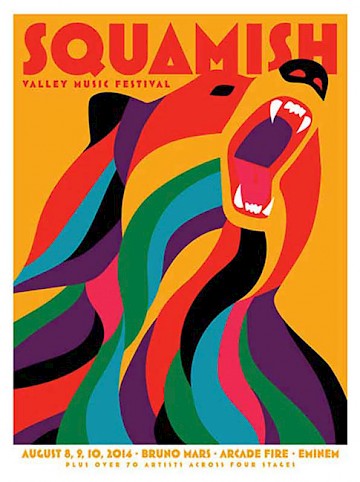 Click to see an entire gallery of work by Dan StilesThat wasn’t a conscious decision, it’s just the way things happened and I ran with it. I started out with pen and ink because that’s what was available to me. I grew up drawing comic book characters, so when I moved into making music stuff I ran with what I knew—Sharpies and stacks of paper stolen from Kinko’s. Aside from April Greiman and a few other digital pioneers, art was still made by hand in the ‘80s. By the time desktop publishing caught on in the ‘90s, I was starting to use computers, but only for production purposes. I had jobs where I did a lot of grunt work in Photoshop, Illustrator and QuarkXPress. That’s where I learned to use the software. Later when I started working in design studios in San Francisco everything we created was digital, and that’s when I started to make this hybridization of the old, lowbrow punk visuals combined with the simplicity of corporate communications, all created using digital tools.
Click to see an entire gallery of work by Dan StilesThat wasn’t a conscious decision, it’s just the way things happened and I ran with it. I started out with pen and ink because that’s what was available to me. I grew up drawing comic book characters, so when I moved into making music stuff I ran with what I knew—Sharpies and stacks of paper stolen from Kinko’s. Aside from April Greiman and a few other digital pioneers, art was still made by hand in the ‘80s. By the time desktop publishing caught on in the ‘90s, I was starting to use computers, but only for production purposes. I had jobs where I did a lot of grunt work in Photoshop, Illustrator and QuarkXPress. That’s where I learned to use the software. Later when I started working in design studios in San Francisco everything we created was digital, and that’s when I started to make this hybridization of the old, lowbrow punk visuals combined with the simplicity of corporate communications, all created using digital tools.
Digital workflow is completely different than working by hand. It used to be that you sketched up an idea. Once you had it worked out, you would redraw a tight comp in non-repro blue pencil, then you would ink it. Any mistakes had to be addressed by pasting pieces of paper with corrections onto your final art. After the inks are done, you would cut your colors out of ruby, or apply them with gouache or whatever. Working digitally doesn’t have a linear process like that. At any point in time you can make radical changes to your design—you can toss 80 percent of it out and keep going. You can start with the color, you can change your type at the last minute, you can adjust scale on the fly. My process has become more like collage. I start out with a rough idea of what I want to do. I draw the elements, then I begin to combine them. There is no line where working on concept stops and execution begins like there is with traditional media. Sometimes I’ll be 80 percent of the way through a piece when I notice something new I could do that makes it stronger. Something that never dawned on me at the beginning.
Why has music become the primary subject matter of your work?
My initial interest in posters stemmed from my love of music. I collected punk and hip-hop fliers off of telephone poles when I was in high school. Music, art and fashion have always been entangled. As a kid, I never gave any thought to fine art. That was just stuff in museums, for academics and rich old people. But graffiti, album covers, T-shirts, posters, skateboards—that’s what drew me into art, and all those things grew from out of the music I loved.
Do you have favorite genres or specific artists that you like creating art for?
Good design comes from understanding. If I can understand something, I can describe it visually. It doesn’t really matter what it is.
What do you listen to when you create? Have your musical tastes grown over time?
One great thing about this line of work is that it forces you to listen to new music constantly, even music you might not usually consider. I recently did some work for Mac DeMarco. I had seen the name but never listened to him before—now he can count me as a fan. My musical choices all depend on my mood. Sometimes I’ll get pumped up and crank Kyuss, Ex Hex or Run The Jewels. Or maybe I’ll chill out with Ladytron, Father John Misty or The Evens. I’m all over the place. I’ve got music going in the studio all day long, so I can cover a lot of bases. Spotify gives me 50 years of music at my fingertips. There’s nothing wrong with listening to The Stooges and Danny Brown back to back.
Who are three Portland bands or artists you’d suggest we listen to?
Red Fang, of course; Sama Dams if you’re feeling mellow and lo-fi; and I’m gonna have to plug Sandrider even though they’re from Seattle. That’s close enough, right?
Besides music, what inspires your work?
Art and design. I look at a lot of stuff. Constantly. And I like to read. I don’t think there is a big difference between drawing and writing. You’re coming up with an idea and then trying to get it down on paper. Writers have a process and work ethic that can easily be applied to visual arts.
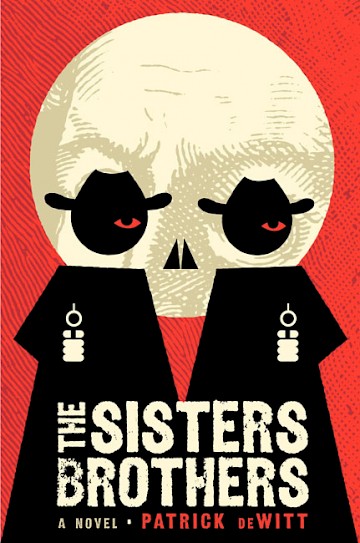 Stiles designed the cover for Portland-based author Patrick deWitt's Booker Prize-nominated bookDo you make anything in addition to posters?
Stiles designed the cover for Portland-based author Patrick deWitt's Booker Prize-nominated bookDo you make anything in addition to posters?
Concert posters are the seed of my career and continue to be what guides me forward. But in reality, I only do one or two of them a month. I’ve grown my practice to include advertising, album covers, book jackets, magazine illustration, fabric design, children’s books, logos, T-shirts. If it needs an image, I’ll design it, regardless of what it is. I’m also expanding my own personal product line, that way I get to design stuff without a client having to ask me to make it first. My wife is a designer as well and we’re moving into housewares and art objects—you can see that work at StubbornStiles.
You have a poster book, One Thing Leads to Another, coming out in June. What made you decide to put that together?
I’ve done a couple of children’s books for Pow! Books, which is an imprint of powerHouse Books that primarily publishes art books. The children’s books got the attention of the editors at powerHouse who asked me if I wanted to put together a book of my posters and design for them. It’s something I’ve wanted to do for a while, so I jumped at the opportunity. The idea with the book is to go behind the images and share some of my process and design philosophy. I wanted to give readers more than they would get if they just bought a poster or browsed some images on the web. Obviously there are hundreds of images in the book, spanning 20 years of poster work, but there are also over a dozen essays on things like color theory, design as art, inspiration, and a six-page interview that gets pretty granular on subjects like learning to print, punk rock, and getting your labia pierced at the mall.
Where can we find it?
The books will be available at all the regular outlets, but as part of my contract I’m getting paid a portion of my advance in books, which I’ll have for sale on my website. If people want to give me maximum support, then buying it directly from my site is the way to go. I’ll try and make it worth it by signing the books and tossing in stickers and such.
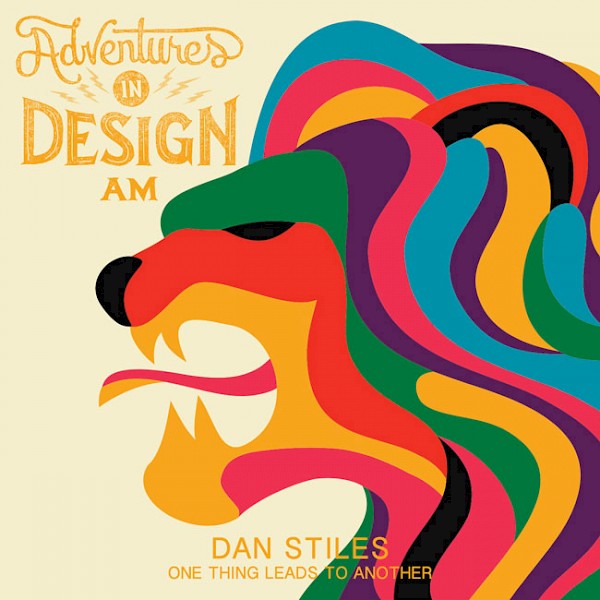
What’s the story behind the name?
One Thing Leads to Another is my philosophy on life. Whatever you do, whatever you make, whatever you put into motion will lead to something else. Pretty much every project I’ve ever done has some earlier project to thank for its existence. A potential client may see something you’ve done, and then call you to do something similar. Or maybe you try out a new technique and it works out, so you use it again, but better. Take a look at the previous question about my book. How did that happen? Because of my children’s books. And how did the children’s books happen? Because of another connection to some children’s art I made for a gallery show. You can trace it back at least 10 steps. Life is a series of actions, and each action can lead to new opportunities. Or perhaps to getting kicked in the balls, if your action was a stupid one.
What advice do you have for someone who wants to do what you do for a living?
Most people get into design to make “cool” stuff. The problem is there’s a rare sort of client who needs this type of work—and they come to you, you don’t go to them. You have to have a body of really great work and then they’ll show up and say, “Give me a piece of that.” But you’ll never create that body of work designing PowerPoint presentations at your day job: You need your own avenue, one where you have 100 percent creative control. Keep your day job, pay your bills, and make something else at night: an awesome blog, posters for your friend’s band, a screen printed zine. Whatever it is, make sure people see it. Don’t make one and then put it in the closet. Get it out into the world and onto the internet. If people like it then it will take flight. Make another one, and then another one, and another one. Work on your chops, develop your style, push your limits. Once you have 20 of something good, people might start to take notice. But you might have to make 100 before you have 20 good ones. Work really hard, make good stuff, build an audience, and give yourself a couple years before all the pieces start to fall into place. I can’t emphasize the work hard part enough. Sell your Xbox, cut your cable, turn off your phone and brew a strong pot of coffee: It's going to be a long few years.

